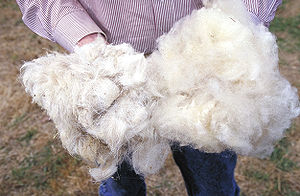Why Wool is Warm to Wear- Heat of Sorption
When a fiber absorbs water, heat is evolved. It results from the attractive forces between the fiber and water molecules. The phenomenon occurs due to the fact that when moisture vapour is absorbed into fiber’s internal structure, it transforms from gas to liquid and the phase change produces the rise in temperature.
It is calculated by heat of wetting. It is the heat evolved when a specimen of the material at a given regain, whose dry mass is one gram is completed is completed wetted.
It is expressed in joules per gram ( of dry material)
The heat of wetting is greatest for the more highly absorbing fibers and is very small in the non-hygroscopic fibers. Thus it is 113 J/g for wool, 106 for viscose, 69 for silk, 55 for flax, 46 for cotton , 73 for mercerized cotton and only 34, 31,5 and 7 respectively for Acetate, Nylon, Polyester and Acrylic.
As we can see from the figures above, wool has the highest heat of sorption. And this heat raises the temperature of the wearer which makes the wool feel warmer. In fact “the heat of sorption from a kg of Merino can be equivalent to the output from an electric blanket over eight hours” (Source ).
You can also find some discussion on Heat of Sorption here.
Now that you've finished reading this post, what are you going do? You should go join the Forum.

![Reblog this post [with Zemanta]](http://img.zemanta.com/reblog_e.png?x-id=65ab4c57-5458-4b7c-88ae-a1e4a17827ff)